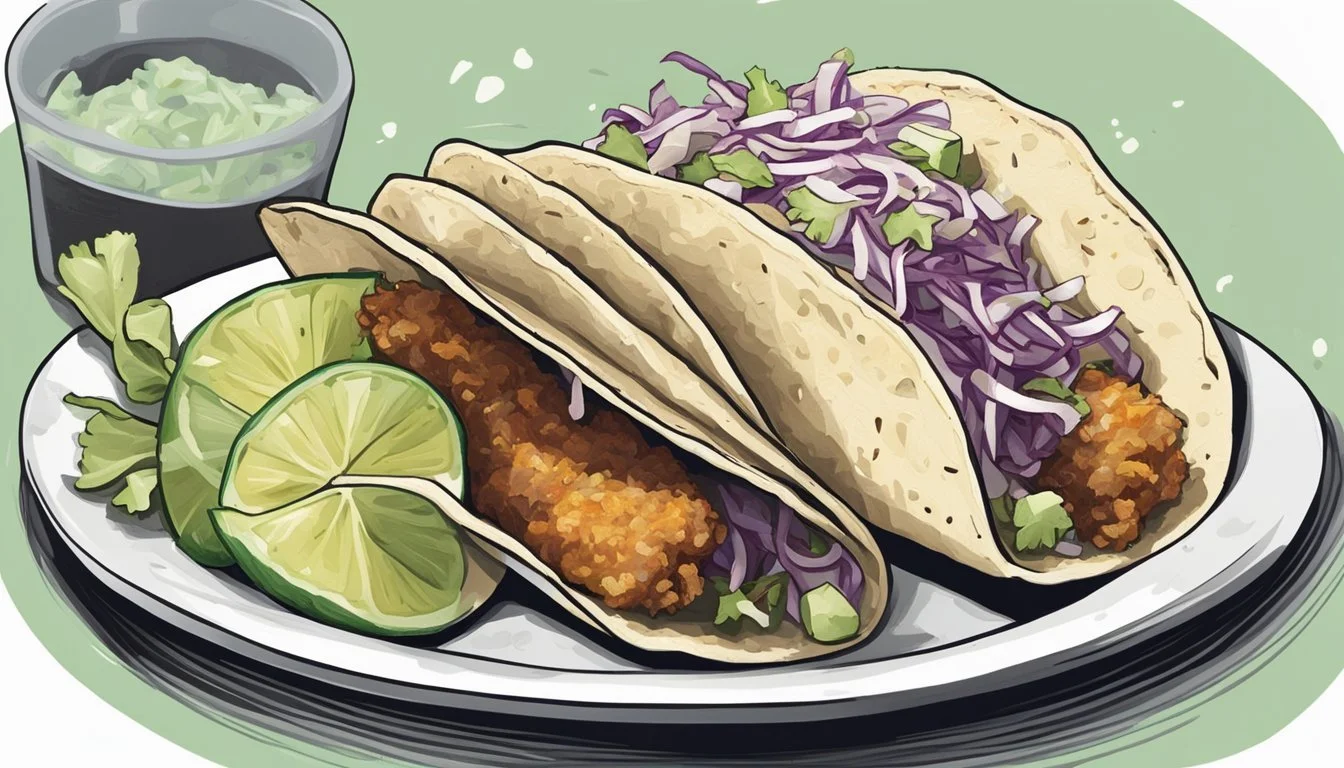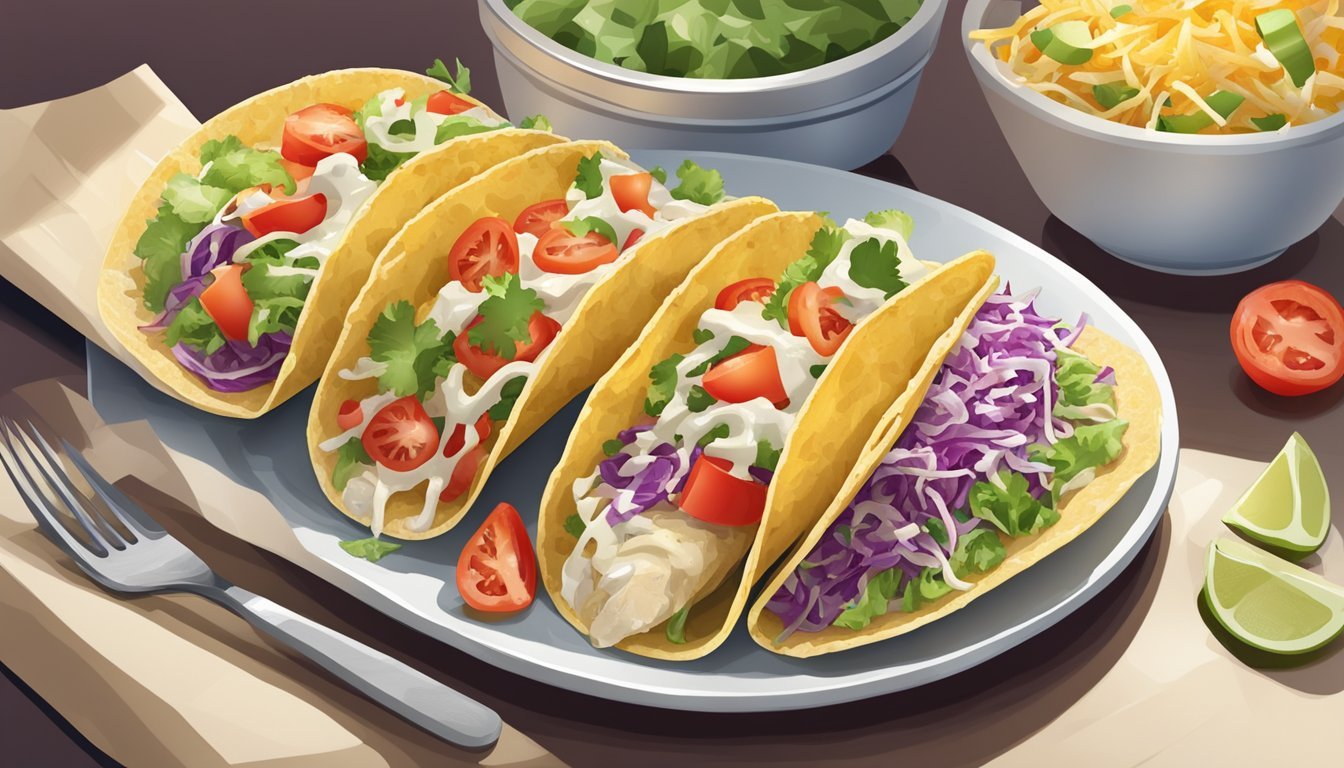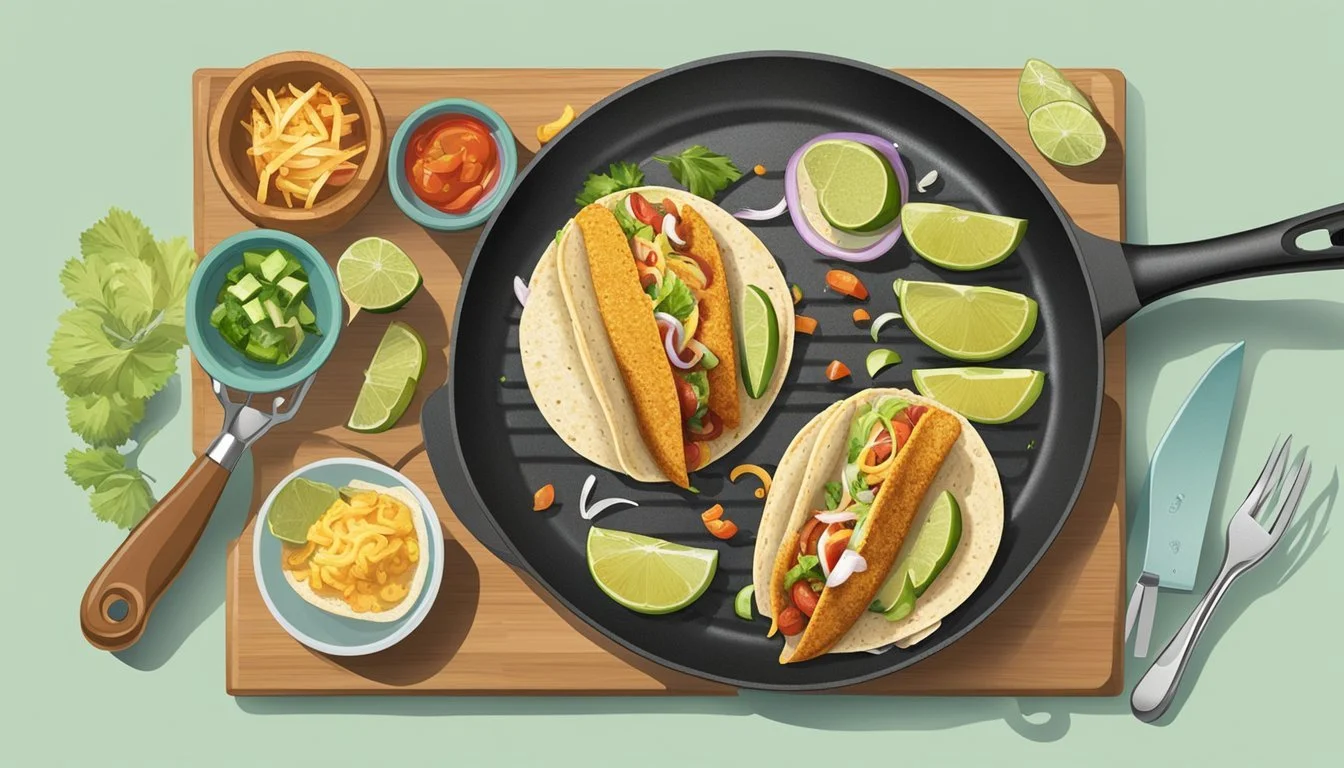How Do You Eat a Fish Taco?
Mastering the Perfect Bite
Eating a fish taco involves a balance of flavors and textures, complemented by the hands-on experience of enjoying a staple in Mexican cuisine. Fish (What wine goes well with fish?) tacos typically consist of grilled or fried fish, a warm tortilla, and an array of toppings such as cabbage slaw, pico de gallo, and a creamy sauce. The type of fish used can vary, with popular options including cod, halibut, and tilapia. The method of cooking the fish also plays a pivotal role in the taco's overall taste and can include seasoning and marinating to enhance the fish's natural flavors.
When consuming a fish taco, diners often look for the perfect bite that combines the crispiness of the fish with the softness of the tortilla and the crunch of fresh toppings. One must handle a fish taco with care to prevent the contents from spilling, particularly with hard-shell tacos which can fracture easily. Soft tacos, on the other hand, offer more flexibility and can be rolled like a burrito to encapsulate the ingredients.
The enjoyment of a fish taco is not just in its taste, but also in the experience of eating it. It's a dish that is often customized to individual preference with a variety of sauces and toppings, allowing for a personal touch with every bite. The freshness of ingredients and the right amount of seasoning are crucial to achieve the ideal fish taco that satisfies the palate.
Essentials of a Fish Taco
When assembling a fish taco, selecting the highest quality ingredients for each element from fish to toppings is fundamental. The perfect fish taco is a harmony of flavors and textures, wrapped in a soft or crispy tortilla.
Choosing the Right Fish
The fish should be fresh and of a suitable variety that remains firm when cooked, such as cod, tilapia, halibut, or snapper. Mahi mahi and haddock are also excellent choices. Fish fillets should be patted dry before cooking to ensure proper searing or grilling.
Selecting Tortillas
The tortilla acts as the base of the taco and it's essential to use one that complements the fish. Both corn tortillas and flour tortillas are widely used. Corn tortillas are traditional and offer a robust flavor, while flour tortillas are softer and more pliable.
Sauces and Seasonings
The right sauce and seasoning bring life to fish tacos. A blend of lime juice, cumin, garlic powder, chili powder, and cayenne pepper can provide a flavor-packed marinade or rub. Fish taco sauce often comprises mayaonnaise, sour cream, and sriracha or citrus for zest.
Preparation Techniques
Fish can be prepared using various cooking techniques such as grilling over an open flame, pan-searing in a nonstick skillet, baking in the oven, or even in an air fryer. Each method provides a different texture and flavor profile to the dish.
Healthy Options
For a healthier version, opt for grilling or baking the fish with a dash of olive oil. Also, consider using toppings like shredded cabbage, avocado, or a corn salad instead of creamy sauces (What wine goes well with creamy sauces?) to reduce calories without sacrificing taste.
Toppings and Extras
Finish your taco with a variety of fresh toppings to add crunch and flavor. Include shredded cabbage, radishes, pico de gallo, guacamole, and lime wedges. Cheese such as cotija adds a savory note, while mango or pineapple introduce a sweet contrast.
Alternative Proteins
While fish is traditional, other seafood options like shrimp can be used to create delightful tacos. Shrimp tacos have become a popular alternative, embracing the same seasonings and toppings as their fish counterparts.
Fish Taco Recipes
Fish tacos offer a versatile and flavorful eating experience, combining tender white fish (What wine goes well with white fish?) with a variety of toppings like cabbage, cilantro (how long does cilantro last?), and a zesty taco sauce. The balance of textures and flavors makes them a favorite. Here are two approaches to crafting delectable fish tacos: a classic version that honors tradition and an innovative twist for those looking to experiment.
Classic Fish Taco
The classic fish taco is both simple and immensely satisfying. It starts with white fish, commonly tilapia or cod, seasoned with a blend of cumin, cayenne pepper, salt, and black pepper. Following the traditional preparation:
Fish Preparation: Season fish evenly and drizzle lightly with olive oil. Place a dot of butter atop each piece and bake at 375°F for 20-25 minutes, or until fish flakes easily with a fork.
Toppings: Combine shredded cabbage, lime juice, and chopped cilantro for a fresh slaw. Blend sour cream with lime juice and a dash of sriracha to create a creamy taco sauce.
Assembly: Warm corn or flour tortillas and fill them with the flaky fish, top with cabbage slaw and a drizzle of the taco sauce.
Innovative Twists
For a fresh take on the traditional fish taco, culinary enthusiasts can introduce new elements like mango for a sweet contrast or a smoky sriracha-infused sauce for added complexity. Here's how to incorporate these twists:
Fish Marinade: Season your choice of white fish with an innovative marinade—lime juice, olive oil, paprika, chili powder, and a touch of cayenne. Let the fish marinate for at least 15 minutes to infuse the flavors.
Tropical Salsa: Mix diced mango with red onion, cilantro, and lime juice to create a sweet and tangy topping.
Sauce Enhancement: Combine sour cream with sriracha, adding honey for a touch of sweetness if desired, to elevate your taco sauce.
To Serve: Cook the fish in a nonstick skillet until done, and serve on warmed tortillas with the mango salsa and spicy taco sauce.
Nutritional Insights
Understanding the nutritional content of fish tacos is essential for those who are health-conscious or have specific dietary needs. This section breaks down the nutritional elements from calorie content to specific dietary considerations.
Calorie Count
A standard serving of a fish taco can typically contain around 270 calories, where the percentage of calories from fat is about 56.7%. This calorie range makes it a moderate option for a meal in terms of energy provision.
Macro and Micro Nutrients
Fish tacos offer a balance of macronutrients—proteins, fats, and carbohydrates—as well as valuable micronutrients. A breakdown of these might typically include:
Protein: Essential for muscle repair and growth, fish tacos can be a good source, especially if made with nutrient-dense fish such as tilapia or cod.
Total Fat: With an average of 17g of fat, it's important to note the type of fat as fish provides healthy omegas.
Carbohydrates: The tortilla and toppings contribute to the carbohydrate content, which is essential for energy.
Fiber: Ingredients like cabbage offer a boost in fiber for digestive health.
Sugar: Typically low in sugar, unless sweetened toppings or dressings are added.
Saturated Fat: Keeping the saturated fat content low is often desired for heart health.
Cholesterol and Sodium: These can vary based on toppings and preparation, with the potential for higher contents.
Nutritional information would vary based on the specific recipe and portion size.
Micronutrients often found in fish tacos might include potassium, vitamin C, calcium, iron, and vitamin A, which are crucial for various bodily functions.
Dietary Considerations
Individuals with different dietary needs can modify fish tacos to suit their preferences:
Healthy Options: One can opt for grilled fish instead of fried to reduce calorie intake.
Kosher Salt: This can be used for seasoning to adhere to kosher dietary laws when necessary.
Gluten-Free Options: Corn tortillas can serve as an alternative for those avoiding gluten.
Nutritional adjustments like these are often necessary to meet personal health and dietary goals.
Cooking Methods and Tools
When preparing fish tacos, the cooking method and tools you choose can significantly influence the texture and flavor of the fish. Selecting the right approach is paramount for achieving the ideal tenderness and taste.
Skillet Techniques
Using a skillet, particularly a nonstick skillet, is a common and effective method for cooking fish for tacos. It allows for a controlled, even heat distribution. Chefs often opt for a light coating of olive oil to prevent sticking and to add a mild, savory flavor. The process typically involves:
Heating the skillet over medium-high heat.
Adding a small amount of olive oil to coat the bottom.
Cooking the fish for 3-4 minutes on each side, until it's opaque and flakes easily.
Baking and Grilling
The oven provides an excellent alternative for creating a flakier texture. Baking fish at a temperature of 375°F to 400°F until it reaches an internal temperature of 140°F - 145°F results in a thoroughly cooked and tender piece suitable for tacos. Meanwhile, the grill imparts a smokier flavor and can be an ideal method during warmer months for outdoor cooking. Here's a simple approach:
To Bake:
Preheat the oven to the recommended temperature.
Lightly drizzle the fish with olive oil or dot with butter.
Bake as directed, flipping once if needed.
To Grill:
Preheat the grill to a medium-high heat.
Place the seasoned fish on a well-oiled grate.
Grill for a few minutes on each side, depending upon thickness.
Air Fryer Usage
The air fryer is a modern kitchen appliance that cooks by circulating hot air around the food. It requires minimal oil, making it a healthier option for achieving a crispy exterior. To use an air fryer for fish tacos, consider:
Preheating the air fryer to the appropriate temperature (typically around 400°F).
Lightly brushing the fish with olive oil to encourage browning.
Cooking for 10-12 minutes or until the fish is cooked through and has a crisp outer layer.
Culinary History and Culture
Fish tacos are a storied Mexican dish that intertwines history with culinary innovation. From historic origins to present-day variations, they remain a beloved food in Mexican culture and are celebrated widely, especially in California and Baja.
Origin and Popularity
Fish tacos have their roots deeply embedded in the coastal regions of Mexico. Indigenous people in these coastal areas are credited with creating the dish, utilizing fresh catches wrapped in stone-ground corn tortillas. This tradition dates back centuries and unfolds a spectrum of developments leading up to the dish's current widespread acclaim. Baja California is often cited as a pivotal area in the fish taco's history, where the combination of fried fish and tortillas became a staple.
Notable points in its history include:
The probable beginnings with indigenous peoples wrapping seafood in corn tortillas.
A transformation in Baja California within the last 50 years that catapulted the taco to fame.
Regional Variations
Mexican fish tacos and Californian interpretations exhibit some distinct differences. In Mexico, particularly in Baja California, the classic fish taco consists of lightly battered and fried fish topped with a mixture of cabbage, crema, and salsa, all nestled in a warm tortilla. This contrasts with some Californian versions that often introduce new ingredients and serve as a testament to the dish's adaptability and the influence of cross-cultural culinary practices.
Key aspects of regional variability:
Baja California often serves as the reference point for authentic Mexican fish tacos.
California's take on the dish frequently reflects a fusion of Mexican tradition with local American tastes.
Celebrating Fish Tacos
Fish tacos are not merely a culinary item; they encapsulate a cultural experience. Various culinary events highlight the dish's significance, drawing participants from local and international locales. Celebrations like National Taco Day, local food festivals, and taco-eating competitions speak to their popularity and cultural impact.
Culinary events often associated with fish tacos:
Food festivals in coastal cities of both Mexico and California.
Special ebook releases detailing the creative recipes and stories behind fish tacos.
Food Pairings and Serving Suggestions
When indulging in the delicious simplicity of fish tacos, pairing with the right side dishes and beverages enhances the experience. Proper serving etiquette ensures each bite is as enjoyable as possible.
Complementary Dishes
Fish tacos pair well with sides that complement their flavor without overpowering them. Here are some specific pairings:
Mexican Sides: Traditional Mexican sides such as Tex-Mex Quinoa Salad or Cilantro Lime Cauliflower Rice add a refreshing contrast to the fish tacos. Essentials like rice and beans also serve as staple sides, providing a balanced meal.
Dishes to Try:
Cilantro Lime Cauliflower Rice
Tex-Mex Quinoa Salad with fresh lime and avocados
Beverage Pairings
The choice of beverage can provide an extra dimension to the meal. Here are some optimal beverage pairings:
Alcoholic Beverages: A cold Mexican beer or a tangy margarita with a salted rim pairs excellently with the slight sweetness of the fish and the savory flavors of the taco seasonings.
Drinks to Serve:
Mexican Beer (e.g., Corona, Modelo)
Serving Etiquette
Fish tacos are typically served with a casual and communal dining approach. Here are some tips on serving etiquette:
Utensils: While fish tacos are traditionally eaten with hands, offering a fork for any side dishes such as rice and beans is advisable.
Garnishes: Provide lime wedges on the side so guests can add an extra zesty touch to their tacos as they desire.







